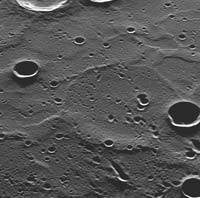|
COMETS EARTH JUPITER KUIPER BELT MARS MERCURY METEORITES NEPTUNE OORT CLOUD PLUTO SATURN SOLAR SYSTEM SPACE SUN URANUS VENUS ORDER PRINTS
PHOTO CATEGORIES SCIENCEVIEWS AMERICAN INDIAN AMPHIBIANS BIRDS BUGS FINE ART FOSSILS THE ISLANDS HISTORICAL PHOTOS MAMMALS OTHER PARKS PLANTS RELIGIOUS REPTILES SCIENCEVIEWS PRINTS
|
Related Documents
Download Options
Date acquired: March 29, 2011 Of Interest: As the MESSENGER spacecraft passed low over Mercury's north polar region, MDIS used its pivot to capture this image, showing terrain that had not been previously seen by spacecraft. The newly imaged surface is located in Mercury's north polar region, to the north of the bright, rayed crater Hokusai. Looking from the bottom of the image toward the top is looking southward, just as MDIS was doing when this image was acquired. This newly seen terrain shows craters with long shadows, as expected at this high northern latitude. Understanding the interiors of the craters in Mercury's polar regions and any ices they may contain is one of the main science goals of the MESSENGER mission. The long shadows also accentuate the topography of the surface, which includes a number of ridges that resemble those seen on the expansive smooth plains imaged during Mercury flyby 3. On March 17, 2011 (March 18, 2011, UTC), MESSENGER became the first spacecraft ever to orbit the planet Mercury. The mission is currently in its commissioning phase, during which spacecraft and instrument performance are verified through a series of specially designed checkout activities. In the course of the one-year primary mission, the spacecraft's seven scientific instruments and radio science investigation will unravel the history and evolution of the Solar System's innermost planet. Credit: NASA/Johns Hopkins University Applied Physics Laboratory/Carnegie Institution of Washington |
